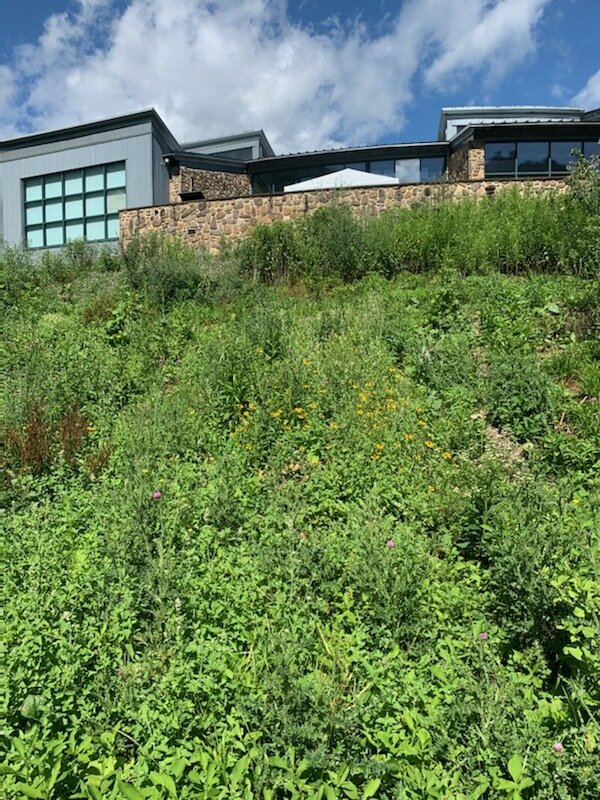The process of installing a native pollinator garden usually involves some trial and error, and may take a few years to finally succeed. We hope that by highlighting the Seneca Rocks Discovery Center’s native pollinator garden, you can take away some lessons from their challenges when building your own garden!
The garden is Blooming!
This is a silvery checkerspot (Chlosyne nycteis) on a black eyed susan in the Seneca Rocks pollinator garden.
In 2016, the Seneca Rocks Discovery Center began building their pollinator garden. Unfortunately, the 2016 planting involved many non-native pollinator plants and, as a result, became difficult to manage. Additionally, these non-native plants do not necessarily have the proper traits (including flower color, flower shape and nectar resources) to adequately provide habitat for native pollinators.
In the spring of 2020, the Center decided to replant with native species. They began this process by tilling the area and covering the plot with black plastic tarp. However, by the fall of 2020, they decided to pull the tarp and re-till the ground due to a high amount of weed activity. While black plastic coverings are a common strategy for killing weeds, the NRCS recommends preparing a pollinator garden by covering the area with clear plastic tarp during the summer. This creates a greenhouse effect and should more effectively kill everything under the tarp.
A blooming yarrow (Achillea millefolium) in the Seneca Rocks pollinator garden.
Later that fall, the Center spread native wildflower seeds on top of the tilled ground and gently stepped on them to ensure seed-to-ground contact. They seeded in the fall because this provides seeds with the best opportunity to germinate. In natural conditions, the seeds would usually drop off of the plant in the fall and then be on the ground for the freezing and thawing throughout the winter and early spring. Therefore, native wildflowers in the area are adapted to this process and do best when they are planted during the late fall.
The Center also decided to plant seeds in a grid formation, which means that each square of ground will have one species of flower. This is fantastic for pollinators, as they do best when they can see clumps of the same color. Additionally, this was intended to help with weeding later on, as each segment should only have one species, and anything unwanted would theoretically be easily visible.
As this is the first summer of the new pollinator garden, the plot has required a lot of upkeep. Once established, native pollinator gardens can manage themselves and will out-compete weeds. However, in order to become established, the first 2-3 years require close monitoring to remove unwanted plant material and give the native plants the best chance of establishing.
Blue flax (Linum lewisii)
To further boost the chance of the plot’s success, a West Virginia Extension Specialist, Dave McGill, assisted with adding biochar to the soil in late March of 2021. Biochar is a soil ameliorate that can assist with nutrient and water retention. As this garden is on a slope, the biochar will ideally assist with any issues regarding nutrient and water runoff.
Overall, as the Seneca Rocks Discovery Center garden matures, it will provide amazing habitat for pollinators and a fantastic pollinator garden demo for the public!
Author: Dayla Woller





